► BMW celebrates its 100th birthday
► Vision Next 100 concept previews the future
► Driverless capability and ‘living’ dashboards
In 30 years’ time cars will drive themselves, internal combustion engines will be pariahs and your cockpit will be transformed. BMW looks into the future. Do you like what it sees?
The Ultimate Driving Machine: that’s one hell of a brand promise, the bedrock of BMW’s engineering, marketing and allure since the ‘70s. But what becomes of the Ultimate Driving Machine brand when the norm is for cars to drive themselves? It’s a question that threatens BMW’s very existence.
This concept car, the BMW Vision Next 100, is an attempt to tackle that dilemma. Unveiled in Munich on the day the company turned 100 years old, it is one BMW vision of the automobile some 30 years from now. And when a company with the foresight of BMW – who led the SUV proliferation, rolled out stop/start with Efficient Dynamics, embraced connectivity and e-mobility with i3 and i8, championed the premium small car with Mini – gives a glimpse of the future, it’s worth taking notice.
Here are six messages we took away from Munich in our head luggage.
1) The Ultimate Driving Machine lives
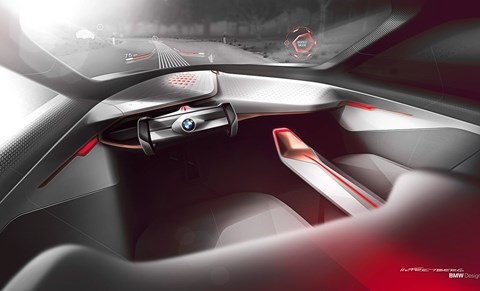 Unlike futuristic transport pods, the BMW Vision does have a steering wheel, though it resembles a chest expander rather than today’s circular object. The message: the car enthusiast of 2046 will still be able to drive – but at a time of their choosing, say on a winding Alpine pass.
Unlike futuristic transport pods, the BMW Vision does have a steering wheel, though it resembles a chest expander rather than today’s circular object. The message: the car enthusiast of 2046 will still be able to drive – but at a time of their choosing, say on a winding Alpine pass.
The twist is that BMW sees the connected car as being able to coach better driving. It imagines the windscreen as a massive head-up display, which will display the optimum line and speed for taking a corner. It could suggest you straddle the centreline to carry velocity, because cloud connectivity enables the car to have visibility around the corner to ascertain there’s no oncoming traffic. BMW calls this enhanced driving ‘boost’ mode.
‘Connectivity, digitalisation and autonomous/semi-autonomous driving give us the chance to strengthen one of the main forces of the last 100 years: to have the driver in the middle of everything,’ says Karim Habib, BMW’s head of design. ‘We think we can make the ultimate driver out of the ultimate driving machine. You have a co-pilot to help you take the curve better and enjoy driving to the maximum.’
Of course there are elephants in the room: being able to see cars hidden around corners demands all hazards are connected – not the case for an enthusiast taking his 2016 classic M2 out for a spin. And if autonomous cars are proven to be more reliable than humans, won’t legislators ban us as the weakest link?
‘Will one day automated driving be mandatory in certain traffic zones?’ responds head of group design Adrian van Hooydonk. ‘We don’t know. All we know is that we’d better be technologically prepared. But we believe individual mobility should be a choice.’
2) Born slippy: a world record drag factor
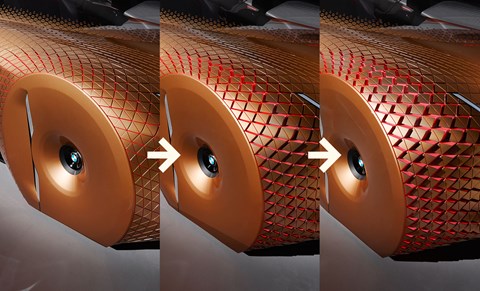 This BMW might look forward 30 years, but in one way it turns the clock back to the ’30s: its streamliner wheels. This is the car’s most striking feature, those four concave dishes at each corner, looking like clay spinning in a potter’s wheel; creating a disconnect between your eye and brain, which are conditioned to process the ubiquitous circle of rubber encasing an alloy wheel.
This BMW might look forward 30 years, but in one way it turns the clock back to the ’30s: its streamliner wheels. This is the car’s most striking feature, those four concave dishes at each corner, looking like clay spinning in a potter’s wheel; creating a disconnect between your eye and brain, which are conditioned to process the ubiquitous circle of rubber encasing an alloy wheel.
So how do the front wheels steer? The wheel and its cover are physically connected, and as the steering turns from the dead ahead, the wheelarch bodywork peels apart to maintain sufficient distance to the spinning tyre. It’s genuinely breath-taking, watching the interlocking layers expand and contract, like a high-tech accordion’s bellows.
‘We have two points of connection, in the front and rear [of the wheel], and when the wheels turn, the surface turns with it,’ explains Karim Habib. He says patents are pending. ‘There’s no flexible material: it’s like pieces of a 3D puzzle that slide on top of each other.’ BMW calls this feature Alive Geometry, a term it also applies to the active head-up display and a shape-shifting dashboard.
Eliminating that turbulence in the wheel wells, combined with other aerodynamic elements, has a profound effect. Without any need to feed air to an engine, the front grille can be closed off, and a rear body section also extends to optimise air flow. The result is a claimed 0.18 coefficient of drag, a world record. That should help eke out a few more electric miles: what will the range anxiety threshold and recharging times of 2046 be?
3) The screen arms race is over – meet the living dashboard
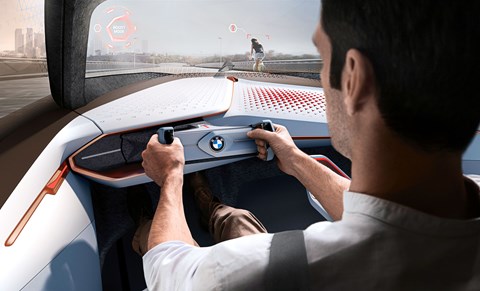
The cockpit of the BMW Vision is more minimalist than a Scotsman’s underwear. There isn’t a single switch or dial, and that physical, analogue experience will be history in three decades, says the man with a very Silicon Valley-sounding job title, Holger Hampf, head of design customer experience. ‘We wanted to step away from direct interaction. We’ve cleaned up the interior to the maximum, got rid of physical interaction points, especially displays. Currently there’s a race for the biggest displays, the best resolution. In the future, most of that can be gone.’
That’s due to emerging control systems. Using gestures is a fledgling, shallow experience in the latest 7-series, and it’s probably easier to communicate via the click language of the southern African San people than use in-car voice control without frustration. But by 2046 both systems should be infallible.
This car also communicates with you, thanks to the second manifestation of Alive Geometry: 800 small indicator triangles spread across the dashboard. In their resting state, they merely provide texture, but if the car’s sensors spot a hazard the triangles move upwards, revealing previously hidden red surfaces. This creates a red wave that ripples across the dash, in the direction of the hazard.
BMW cites the example of a bicycle courier, whose appearance from the right is indicated by a pulse of the Alive Geometry triangles on the right-hand-side. If the courier then disappears from view behind a parked lorry, the BMW Vision will have calculated his trajectory and speed, and continue to signal his likely reappearance in your path with the animated dashboard. ‘Without harsh acoustic signals or warning lights, we can change the dashboard geometry to give a subtle warning that something may happen in the next few seconds,’ says Hampf.
The cockpit is noticeably clean and spacious, shorn of the clutter of switches and physical intrusions such as a tranmission tunnel. The materials are fully recyclable, and the BMW Vision makes a stand against the use of cattle skin: the seats are trimmed in alcantara and cashmere, rather than leather.
Unlike Mercedes’ futuristic F015 concept, the BMW Vision does not have swivelling chairs to foster social interaction – such a feature calls for a much larger vehicle. The BMW’s seats have been designed to let you lounge: the edges use softer foam, and combine with the door contours to create an enticing, lean-back position. But you can’t turn your back on the road ahead. A statement that underlines BMW’s aspiration to keep car enthusiasts in control – and the company in control of its own destiny, at the forefront of the car’s technological revolution.
4) There’s self-driving capability too
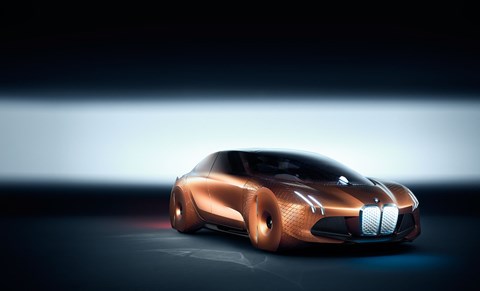
The alternative to boosted driving is ‘ease’ mode. The steering wheel retracts into the dash, and the vehicle becomes fully autonomous, though control can revert to the driver within 5secs to meet legislative requirements.
BMW believes it’s important to tell the outside world that the car is driving itself, so there’s a physical manifestation of the companion – a diamond-shaped crystal – which rises from the dash so its glow is visible in the windscreen. Shades of K.I.T.T.’s swivelling red scanning eye in Knight Rider, although BMW’s companion turns green, to communicate that pedestrians are safe to use that pelican crossing for instance.
What does the driver get up to while virtual Parker does its thing? Van Hooydonk’s team imagines joining a video conference to review the latest designs on the windscreen’s head-up display: there really is no downtime when you’ve got to stay one step ahead of technological extinction.
5) It’s a car but not quite as we know it
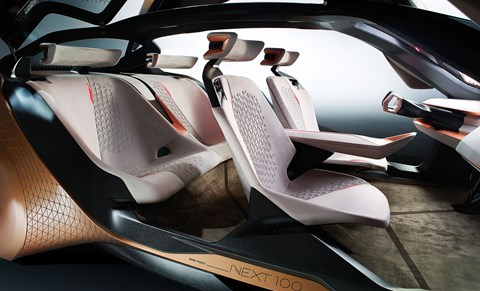
It’s part car, part molten bronze jelly mould. The BMW Vision resembles the familiar three-box saloon, with the rear lip hinting at a boot, and the bonnet suggesting the horseless carriage configuration established with the dawn of the automobile. But BMW has subverted the form into a teardrop-shaped, ‘almost one-box monovolume’, according to Karim Habib. That helps stretch cabin volume in both directions: the concept is the size of a 5-series, but with the interior space of a 7-series.
Trademark BMW design cues are visible, such as the four headlamps and the kidney grille, but again subverted. So today’s rounded lamps make way for four minimalist light bars, and the double grille isn’t for engine cooling but to house the sensors which allow the car to decode its surroundings. BMW won’t elaborate on the powertrain other than that it employs electric propulsion and emits zero emissions. ‘Yes, it will be very dynamic and very fast, the limousine of the future could be even faster than today’s. That can be achieved in many different drivetrain ways,’ says Adrian van Hooydonk. ‘We all just hope we will be able to deliver the right driving sensations in the future.’
6) The man who has to divine the future
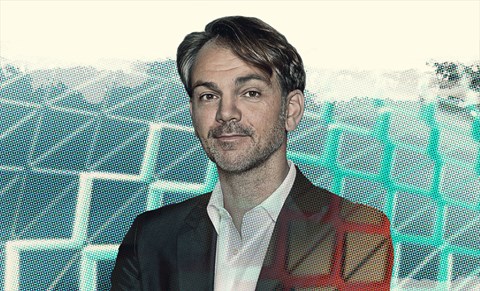
Today’s car designers grew up sketching wedgy supercars on planet-sized wheels. Ironically however, the Ultimate Driving Machine brand hasn’t sold an undiluted supercar since the ’70s, and the closest silhouette in its current range is a three-cylinder-engined plug-in hybrid. That sums up the way the car world is changing, and the man charged with visualising BMW’s future is group senior vice president of design Adrian van Hooydonk.
‘In the past you’ve asked us “Is the i8 just a sideshow: what happens in the core of the brand?” Here we’ve decided to attack that core, a sporty limousine, to put in everything we’ve learned plus a few things we’ve imagined. I hope that 30 years from now I’m not laughing at it. The design is so clean, I believe it might stand the test of time.’
In 2046, van Hooydonk will be 82 – five years older than the perennial Giugiaro is now. By then, the Dutchman will know which alternative powertrain came to dominate, and the year of the autonomous car tipping point. ‘We believe that will become a technical reality within 15 years. Will everybody then still want to drive? Probably not. But BMW’s brands cater for people who love to drive, and that’s why we were adamant this concept should have a steering wheel.’
The understated executive expects interior design to become more important and creative as autonomy takes drivers’ attention off the road, and that future computing power should enable shape-shifting cars as per the Alive Geometry wheels. ‘We tried our best to imagine what the future will bring. We cannot predict it but we can take a stance. BMW feels this is very important: to try to shape the future – before it shapes you.’
Same future, different badge: Mercedes has been at it too
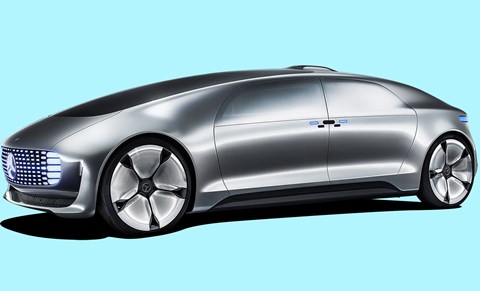
F015 concept (2015)
Like the BMW this ‘S-class after next’ has a retractable steering wheel and uses changing light colours to tell other road users when it’s in autonomous mode. Unlike the BMW, its front seats swivel 180 degrees to form a ‘lounge’.
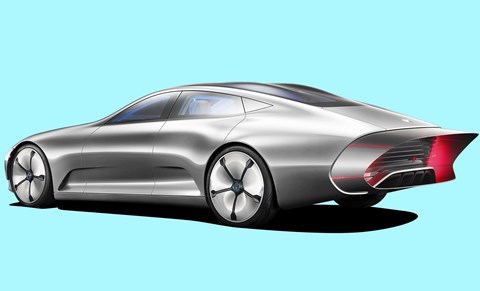
Concept IAA (2015)
Like the BMW this ‘shape-shifting coupe’ uses radical active aerodynamics, including a tail that extends by 390mm above 50mph and dished wheels which become shallower with speed. Unlike the BMW it has a petrol electric drivetrain and pretty much an E-class cockpit.
Read more from the May 2016 issue of CAR magazine